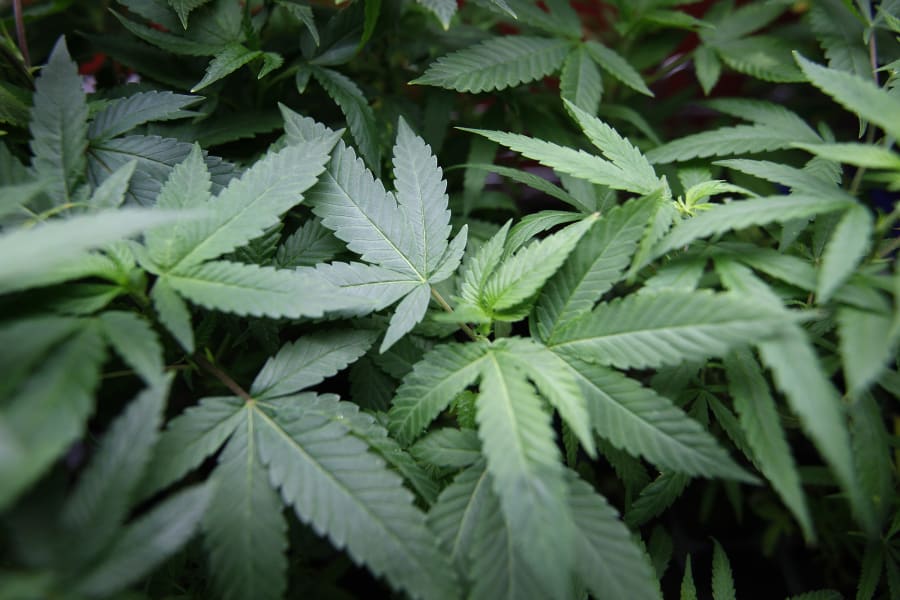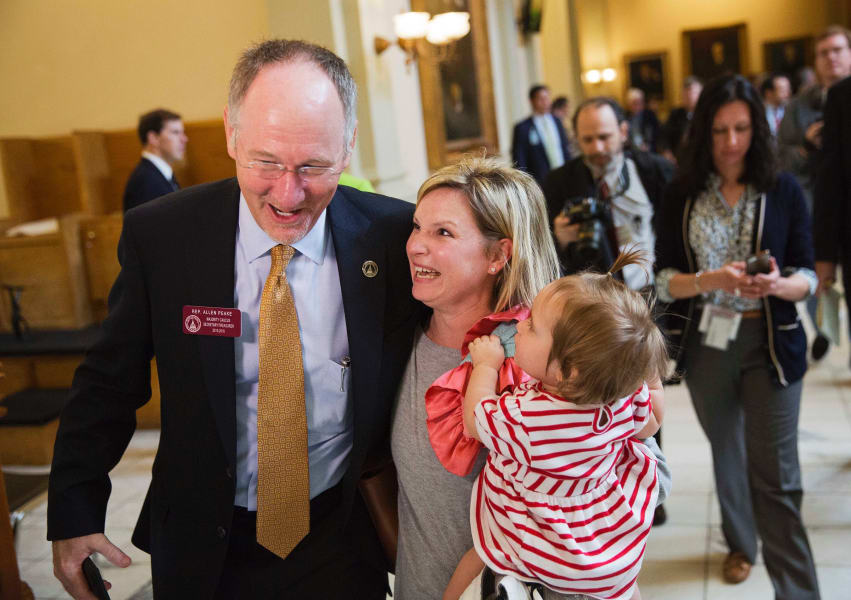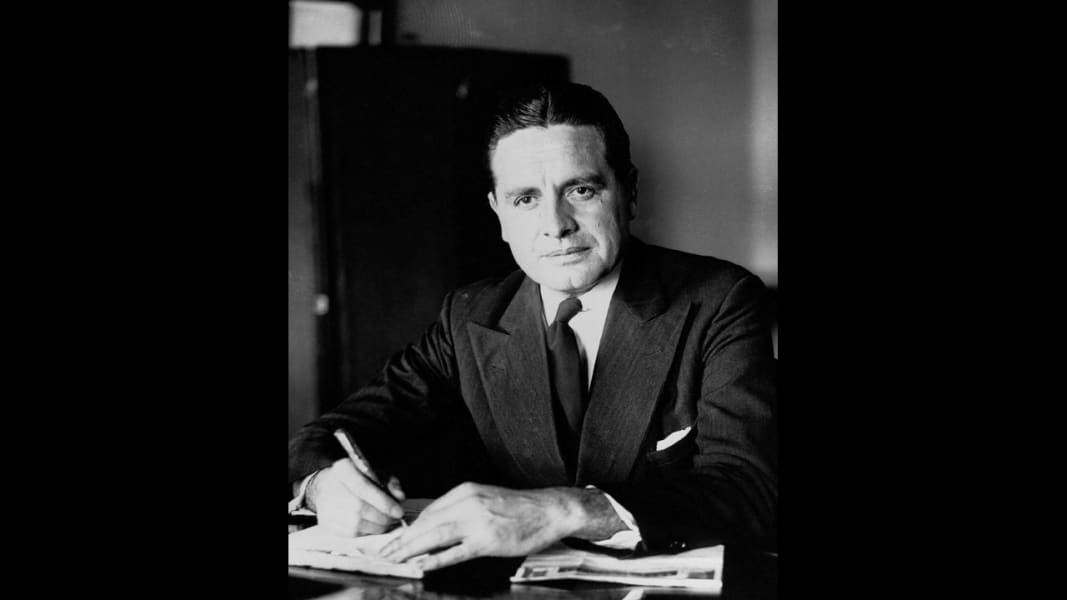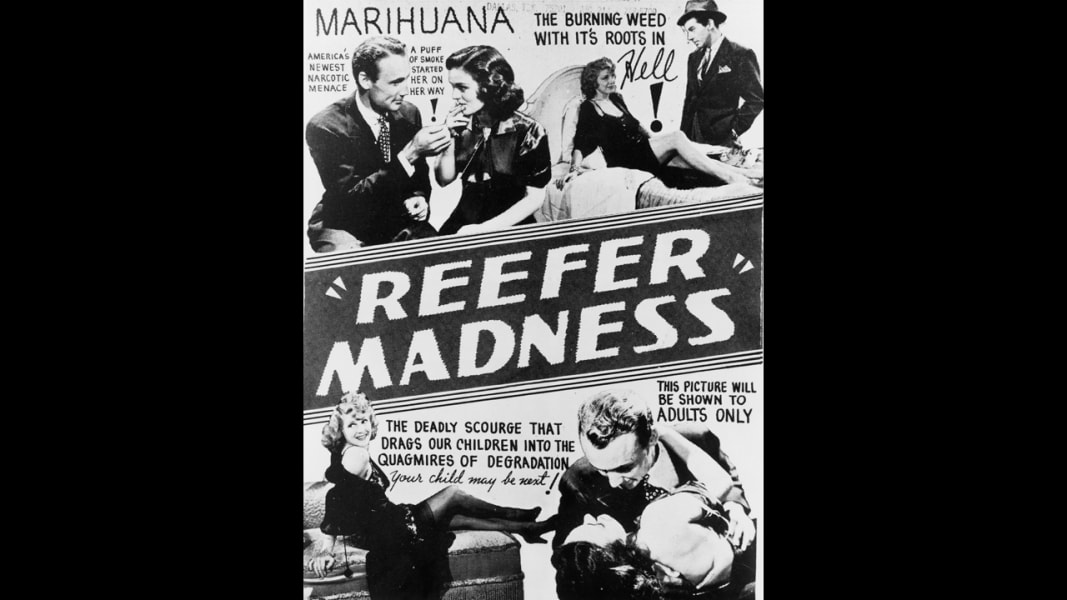Share


1 of 41
Public perceptions about pot have come a long way, from the dire warnings of "Reefer Madness" to growing acceptance of medical marijuana and the legalization of recreational use. David McNew/Getty Images
Harry Anslinger was named commissioner of the Federal Bureau of Narcotics when it was established in 1930. While arguing for marijuana prohibition, he played on Americans' fear of crime and foreigners. He spun tales of people driven to insanity or murder after ingesting the drug and spoke of the 2 to 3 tons of grass being produced in Mexico. "This, the Mexicans make into cigarettes, which they sell at two for 25 cents, mostly to white high school students," Anslinger told Congress. AP Photo
A poster advertises the 1936 scare film "Reefer Madness," which described marijuana as a "violent narcotic" that first renders "sudden, violent, uncontrollable laughter" on its users before "dangerous hallucinations" and then "acts of shocking violence ... ending often in incurable insanity." Hulton Archive/Getty Images
Marijuana cigarettes are hidden in a book circa 1940. Congress passed the Marijuana Tax Act in 1937, effectively criminalizing the drug. Keystone-France/Gamma-Keystone via Getty Images
Even after Congress cracked down on marijuana in 1937, farmers were encouraged to grow the crop for rope, sails and parachutes during World War II. The "Hemp for Victory" film was released in 1942 by the U.S. Department of Agriculture. U.S. Department of Agriculture/AP
A woman buys ready-rolled marijuana cigarettes from a dealer at her door circa 1955. Vecchio/Three Lions/Getty Images
Members of the Grateful Dead talk with reporters from their home in San Francisco on October 5, 1967. The band was protesting being arrested for marijuana possession. AP Photo
U.S. Customs agents track the nationwide marijuana market during Operation Intercept, an anti-drug measure announced by President Nixon in 1969. The initiative intended to keep Mexican marijuana from entering the United States. Michael Rougier//Time Life Pictures/Getty Images
Research scientist Dr. Reese T. Jones, right, adjusts the electrodes monitoring a volunteer's brain response to sound during an experiment in 1969 that used a controlled dosage of marijuana. The tests were conducted at the Langley Porter Institute at the University of California, San Francisco. Ralph Crane//Time Life Pictures/Getty Images
Marijuana use became more widespread in the 1960s, reflecting the rising counterculture movement. Michael Ochs Archives/Getty Images
People share a joint during a 1969 concert in Portland, Oregon. In 1973, Oregon became the first state to decriminalize cannabis. Steven Clevenger/Getty Images
Police dogs trained to smell out hidden marijuana examine U.S. soldiers' luggage at the airport during the Vietnam War in 1969. Drug use was widespread during the war. Dick Swanson//Time Life Pictures/Getty Images
Marijuana reform was the Life magazine cover story in October 1969. The banner read: "At least 12 million Americans have now tried it. Are penalties too severe? Should it be legalized?" Co Rentmeester/Time & Life Pictures/Getty Images
Protesters wade in the Reflecting Pool at the National Mall in Washington during the "Honor America Day Smoke-In" thrown by marijuana activists in response to the official "Honor America Day" rally organized by President Nixon supporters at the Lincoln Memorial on July 4, 1970. David Fenton/Getty Images
Panel members of the National Commission on Marijuana and Drug Abuse attend a hearing In Denver on January 10, 1972. From left, Dr. J. Thomas Ungerleider, psychiatrist; Michael R. Sonnenreich, commission executive director; Raymond P. Shafer, commission chairman; Mitchell Ware, Chicago attorney; Charles O. Galvin, Dallas law school dean. The commission's findings favored ending marijuana prohibition and adopting other methods to discourage use, but the Nixon administration refused to implement its recommendations. Bill Johnson/Denver Post/Getty Images
President Jimmy Carter, with his special assistant for health issues, Dr. Peter Bourne, beside him, talks to reporters at the White House about his drug abuse control message to Congress on August 2, 1977. Among other things, he called for the elimination of all federal criminal penalties for the possession of up to one ounce of marijuana. Bob Daugherty/AP
First lady Nancy Reagan participates in a drug education class at Island Park Elementary School on Mercer Island, Washington, on February 14, 1984. She later recalled, "A little girl raised her hand and said, 'Mrs. Reagan, what do you do if somebody offers you drugs?' And I said, 'Well, you just say no.' And there it was born." She became known for her involvement in the "Just Say No" campaign. Barry Sweet/AP
Robert Randall smokes marijuana that was prescribed to treat his glaucoma in 1988. He became the first legal medical marijuana patient in modern America after winning a landmark case in 1976. Terry Ashe//Time Life Pictures/Getty Images
President George H. Bush holds up a copy of the National Drug Control Strategy during a meeting in the Oval Office on September 5, 1989. In a televised address to the nation, Bush asked Americans to join the war on drugs. Barry Thumma/AP
A television ad aired in 1996 by Republican presidential candidate Bob Dole's campaign included footage from a 1992 MTV interview of a laughing President Clinton saying he would inhale marijuana if given the chance to relive his college days. Dole Campaign/AP
Dennis Peron takes notes during a phone interview while Gary Johnson lights up at the Proposition 215 headquarters in San Francisco on October 11, 1996. The ballot measure was approved when voters went to the polls in November, allowing medical marijuana in California. Peron Robinson/AP
People in New York gather for a pro-cannabis rally on May 4, 2002. That same day, almost 200 similar events took place around the world to advocate for marijuana legalization. It was dubbed the "Million Marijuana March." Spencer Platt/Getty Images
Different varieties of medical marijuana are seen at the Alternative Herbal Health Services cannabis dispensary in San Francisco on April 24, 2006. The Food and Drug Administration issued a controversial statement a week earlier rejecting the use of medical marijuana, declaring that there is no scientific evidence supporting use of the drug for medical treatment. Justin Sullivan/Getty Images
Medicinal marijuana patient Angel Raich wipes her eyes during a press conference on March 14, 2007, in Oakland, California. The 9th circuit U.S. Court of Appeals in San Francisco ruled that 41-year-old Raich, who used medicinal marijuana to curb pain from a brain tumor as well as other ailments, did not have the legal right to claim medical necessity to avoid the possibility of prosecution under federal drug laws. Justin Sullivan/Getty Images
Coffeeshop Blue Sky worker Jon Sarro, left, shows a customer different strains of medical marijuana on July 22, 2009, in Oakland, California. Voters in the city approved a measure during a vote-by-mail special election for a new tax on sales of medicinal marijuana at cannabis dispensaries. Justin Sullivan/Getty Images
A patient prepares to smoke at home in Portland, Maine, on October 22, 2009, a decade after the state approved a medical marijuana referendum. Robert F. Bukaty/AP
Sonja Gibbins walks through her growing warehouse in Fort Collins, Colorado, on April 19, 2010. Since the state approved medical marijuana in 2000, Colorado has seen a boom in marijuana dispensaries, trade shows and related businesses. So far 20 states and the District of Columbia have made smoking marijuana for medical purposes legal. Chris Hondros/Getty Images
Marijuana activist Steve DeAngelo wears a "Yes on Prop 19" button as he speaks during a news conference in Oakland, California, on October 12, 2010, to bring attention to the state measure to legalize marijuana for recreational purposes in California. Voters rejected the proposal. Justin Sullivan/Getty Images
Nutrient products are placed on shelves in the weGrow marijuana cultivation supply store during its grand opening on March 30, 2012, in Washington, D.C. The store is a one-stop-shop for supplies and training to grow plants indoors, except for the actual marijuana plants or seeds. Legislation was enacted in 2010 authorizing the establishment of regulated medical marijuana dispensaries in the nation's capital. Alex Wong/Getty Images
People light up near the Space Needle in Seattle after the law legalizing the recreational use of marijuana went into effect in Washington on December 6, 2012. Cliff Despeaux/Reuters/Landov
A man smokes a joint during the official opening night of Club 64, a marijuana social club in Denver, on New Year's Eve 2012. Voters in Colorado and Washington state passed referendums to legalize recreational marijuana on November 6, 2012. Brennan Linsley/AP
Members of a crowd numbering tens of thousands smoke and listen to live music at the Denver 420 Rally on April 20, 2013. Annual festivals celebrating marijuana are held around the world on April 20, a counterculture holiday. Brennan Linsley/AP
Sean Azzariti, an Iraq war veteran and marijuana activist, becomes the first person to legally purchase recreational marijuana in Colorado on January 1, 2014. Colorado was the first state in the nation to allow retail pot shops. "It's huge," Azzariti said. "It hasn't even sunk in how big this is yet." Gary C. Caskey/UPI/Landov
In April 2014, Maryland became the 18th state to decriminalize marijuana possession. Research published by the Pew Research Center in February showed 54% of Americans support legalization of marijuana. Linda Davidson/The Washington Post
Matt Figi's 7-year-old daughter, Charlotte, was once severely ill. But a special strain of medical marijuana known as Charlotte's Web, which was named after the girl early in her treatment, has significantly reduced her seizures. In July 2014, Rep. Scott Perry, R-Pennsylvania, introduced a three-page bill that would amend the Controlled Substances Act -- the federal law that criminalizes marijuana -- to exempt plants like Charlotte's Web that have an extremely low percentage of THC, the chemical that makes users high. Brennan Linsley/AP
In July 2014, the New York Times published "High Time: An Editorial Series on Marijuana Legalization," which called for the federal government to repeal its ban on marijuana. Ramin Talaie/Getty Images/FILE
Alaska Cannabis Club CEO Charlo Greene prepares to roll a joint at the medical marijuana dispensary in Anchorage on February 20, 2015. Several days later, Alaska became the third state in the nation to allow recreational marijuana. Mark Thiessen/AP
A woman smokes pot at her home in Washington on February 26, 2015, the first day it was legal to possess marijuana for recreational purposes in the nation's capital. Democratic Mayor Muriel Bowser defied threats from Congress by implementing a voter-approved initiative, making the city the only place east of the Mississippi River where people can legally grow and share marijuana in private. Alex Brandon/AP
Employees make last-minute preparations before the grand opening of the Cannabis Corner in North Bonneville, Washington, on March 7, 2015. The pot shop is the first city-owned recreational marijuana store in the country. JASON REDMOND/Reuters/LANDOV
Georgia Rep. Allen Peake celebrates with Kristi Baggarly, holding her daughter Kimber, after the state Senate approved Peake's medical marijuana bill March 24, 2015 in Atlanta. The bill will legalize possession of cannabis oil for treatment of certain medical conditions, such as the seizures suffered by Baggarly's daughter Kendle. David Goldman/AP
An employee at Kaya Shack, a Portland, Oregon, medical marijuana dispensary, showcases three types of marijuana sold at the shop on June 26, 2015. Oregon legalized recreational marijuana use on July 1, 2015. Gosia Wozniacka/AP
















































